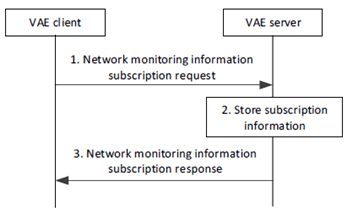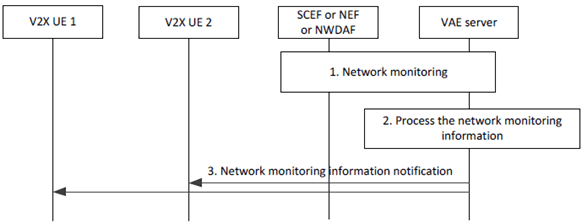Content for TS 23.286 Word version: 18.4.0
0…
4…
6…
7…
9…
9.2…
9.3…
9.4…
9.5…
9.6…
9.7…
9.8…
9.9…
9.10…
9.11…
9.12…
9.13…
9.14…
9.15…
9.16…
9.17…
9.18
9.19…
9.20…
9.21…
9.22…
10…
10.2.8…
A
B…
C…
D…
9.7 Network monitoring by the V2X UE
9.7.1 General
9.7.2 Information flows
9.7.2.1 Network monitoring information subscription request
9.7.2.2 Network monitoring information subscription response
9.7.2.3 Network monitoring information notification
9.7.3 V2X UE subscription for network monitoring information
9.7.3.1 General
9.7.3.2 Procedure
9.7.4 Notifications for network monitoring information
9.7.4.1 General
9.7.4.2 Procedure
...
...
9.7 Network monitoring by the V2X UE p. 47
9.7.1 General p. 47
The V2X UE subscribes for network monitoring information from the VAE server. Such network monitoring information may be used by the V2X UE for network connectivity adaptations (e.g. switching between different modes of operations for V2V communications).
9.7.2 Information flows p. 47
9.7.2.1 Network monitoring information subscription request p. 47
Table 9.7.2.1-1 describes the information flow network monitoring information subscription request from the VAE client to the VAE server.
| Information Element | Status | Description |
|---|---|---|
| V2X UE ID | M | Identity of the V2X UE subscribing for the network monitoring information. |
| Subscription event | M | Identify one or multiple network monitoring events (e.g. uplink degradation, congestion, overload, coverage). |
| Triggering criteria | M | Identify when the VAE server will send the monitoring reports to the VAE client. |
| Area information | O | Identify the area where the event is subscribed. |
| V2X UE ID(s) | O | Identify the V2X UE(s) to be monitored. |
| V2X service ID(s) | O | Identify the V2X service which is related with the event. |
9.7.2.2 Network monitoring information subscription response p. 48
Table 9.7.2.2-1 describes the information flow network monitoring information subscription response from the VAE server to the VAE client.
| Information Element | Status | Description |
|---|---|---|
| V2X UE ID | M | Identity of the V2X UE |
| Result | M | Indicates success or failure |
9.7.2.3 Network monitoring information notification p. 48
Table 9.7.2.3-1 describes the information flow network monitoring information notification from the VAE server to the VAE client.
| Information Element | Status | Description |
|---|---|---|
| V2X UE ID | M | Identity of the subscribed V2X UE |
| Network monitoring information (NOTE 2) | M | This includes information on network status for the triggering criteria, and may include the following parameters:
|
| V2X UE ID (NOTE 2) | O | Identify the V2X UE that the network monitoring information is related. |
|
NOTE 1:
With respect to the congestion information acquired from 5GC, it may be exact values for congestion status reported by NWDAF to NEF or abstracted values e.g. (High, Medium, Low) which can be reported by the NEF.
NOTE 2:
If subscription is for multiple V2X UE IDs, then multiple Network monitoring information IEs corresponding to V2X UE ID(s) can be present.
|
||
9.7.3 V2X UE subscription for network monitoring information p. 49
9.7.3.1 General p. 49
This subclause describes the procedure for V2X UE subscription for network monitoring information.
9.7.3.2 Procedure p. 49
Figure 9.7.3.2-1 illustrates the procedure where the V2X UE subscribes for the network monitoring information from the VAE server.
Pre-condition:
- The VAE client of the V2X UE is connected to the VAE server and is authorized to access the network monitoring information.

Figure 9.7.3.2-1: V2X UE subscription for network monitoring information
(⇒ copy of original 3GPP image)
(⇒ copy of original 3GPP image)
Step 1.
The VAE client sends a network monitoring information subscription request to the VAE server. The area information and/or the V2X UE ID(s) (e.g., the initiating V2X UE ID, the V2X UE ID(s)) is included to indicate whether per area or per UE(s) networking monitoring information is subscribed.
Step 2.
The VAE server checks for the authorization of the VAE client to access the network monitoring information and if allowed, stores the subscription information corresponding to the V2X UE.
Step 3.
The VAE server sends a network monitoring information subscription response to the VAE client including the result of the subscription (i.e. success or failure).
9.7.4 Notifications for network monitoring information p. 49
9.7.4.1 General p. 49
This subclause describes the procedure for notification of network monitoring information from the VAE server.
9.7.4.2 Procedure p. 49
Figure 9.7.4.2-1 illustrates the procedure where the VAE server sends notification of the network monitoring information to the V2X UEs.
Pre-conditions:
- The VAE server acting as a SCS/AS is configured with the SCEF information and is authorized to exchange information with the SCEF as specified in subclause 4.9 in TS 23.682. The VAE server has subscribed to QoS notification service from 5GS (e.g. PCF/NWDAF). The notification may either include the request for QoS sustainability events as specified in TS 23.288 or can include a QoS change notification requests as provided by SMF and specified in TS 23.287;
- The V2X UE1 and V2X UE2 have subscribed for the network monitoring information at the VAE server.
- The VAE server may be aware of the RAT type the V2X UE supports from the registration of VAE client.

Step 1.
The VAE server communicates with the SCEF to receive network monitoring information as per the procedure in subclause 4.9 of TS 23.682, and/or communicates with NEF or NWDAF to receive QoS monitoring information and/or data analytics information of 5GS as defined in TS 23.288 for the requesting area and/or the V2X UE(s). The VAE server may determine to receive network monitoring information from EPC or 5GC or both considerting the RAT type provided by the UE. The VAE server subscription to QoS monitoring service from 5GS (e.g. PCF/NWDAF) may be active for a certain period of time or a given geographical area and/or the V2X UE(s). The monitoring may either include the request for QoS sustainability events as specified in TS 23.288, or can include a QoS change notification requests as provided by SMF and specified in TS 23.287. The reporting may be configured by the application enabler layer for a given area, V2X UE(s), time, periodicity etc taking into account the service requirement and other parameters (e.g. expected congestion in certain area, time of the day, road conditions). Based on the subscription, as specified in TS 23.287, 5GS provides the extended QoS monitoring report, over N33 interface. This report may come either from NWDAF or SMF via PCF/NEF.
Step 2.
The network monitoring information (e.g. uplink or downlink link degradations, congestions, etc.) available at the VAE server about the on-going V2V session(s) and the network status is based on the original network monitoring information provided by the SCEF in step 1, and/or based on QoS monitoring report or data analytics from 5GS as specified in step 1. The VAE server determines the network monitoring information to send to the UE.
Step 3.
The monitoring information is sent to the subscribed V2X UEs via network monitoring information notification.